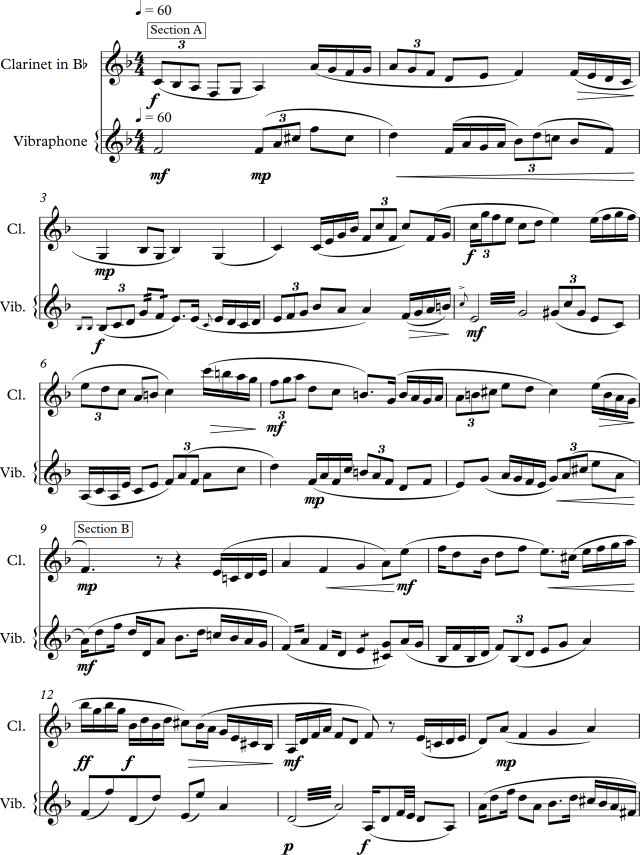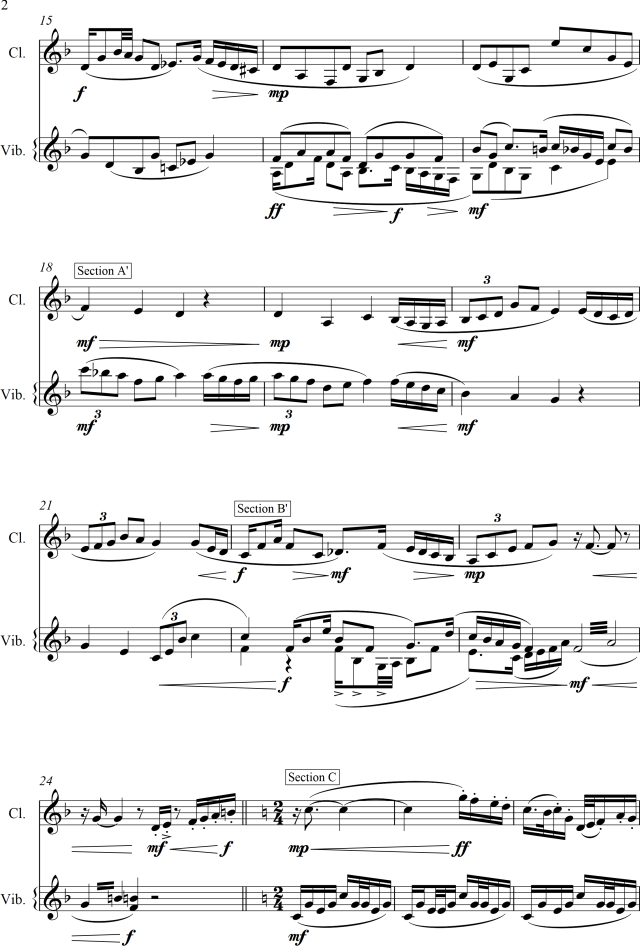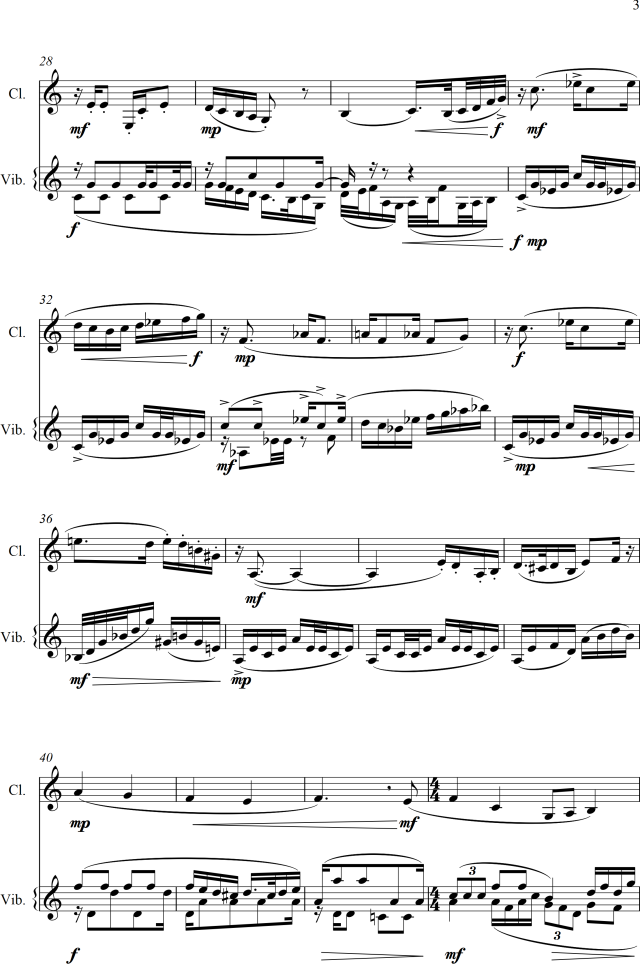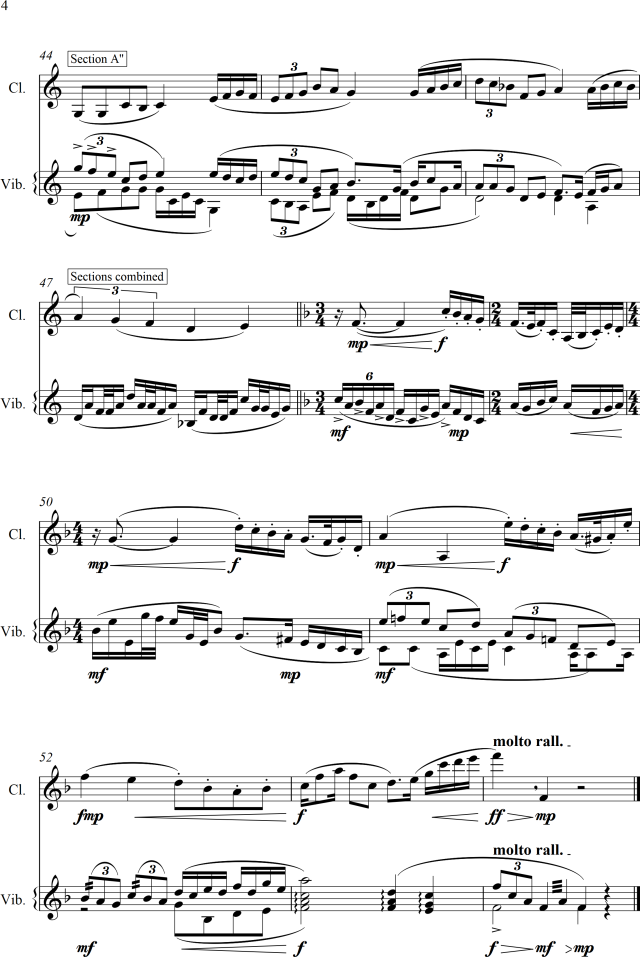Introduction
As opposed to my project 12, this one will (hopefully) be less demanding to the listener. This was one of the goals I wanted to achieve. The device I used most is the imitation, with a smaller presence of inversions and a couple of augmentations. From the beginning I kept in mind I’d like to show some contrary motion and parallel motion at some point.
Planning
Three minutes is longer than what I am used to write. I prepared a table to draft the structure, planning three sections for it, as seen before in the course. It originally looked more or less as follows:
|
section |
lasting |
bars |
character |
key signature / scale(s) |
time signature |
counterpoint devices |
|
A |
32” |
8 |
intimate, but lively as well |
F |
4q |
imitation |
|
B |
24” |
6 |
Dm |
4q |
inversion |
|
|
C |
32” |
8 |
contrast |
augmentation |
||
|
C’ |
32” |
8 |
fugued? |
transposed Bb? Am? |
as before |
|
|
A’ |
32” |
8 |
transposed C? |
4q |
as before |
|
|
B’ |
24” |
6 |
transposed + back to first Cm – C7 |
4q |
as before |
|
|
total |
2′ 56” |
44 |
Most of these things were going to change in the end, but some were kept quite exactly, as we will see.
The final work is based on three sections, A, B, and C, each with its own rhythmical pattern and melody line. A and B are repeated in a shorter way and undergo a series of variations. All three combine in a final section.
As mentioned in the introduction, imitation is the device most used in this piece, with some presence of inversion and augmentation-diminution.
A detailed analysis of the piece will follow after the score, which can be played here.
-
Section A (bars 1-8)
As planned, it is a rather intimate section, slow, with a rhythm based on a number of notes different in each beat (3, 2, 1, then 4 and again 3, 2, etc.). The motif is built mainly on this rhythmical base, with the melody played alternatively by the clarinet or the vibraphone, imitating one each other and with some inversions (exact or at different intervals). From the original plan of 8 bars in F major, I turned to a change in C major in bar 5.
-
Section B (bars 9-17)
This part starts on D minor. The main motif for this section starts on the vibraphone. Not supposed to create too big a contrast, both the rhythm and the shape of the melodic line are very similar to those from section A. The clarinet plays an inversion in bars 11-12. The rest of the section is mainly composed by imitations of the first bar of the B motif (clarinet in bars 13, 15, this one transposed to G; vibraphone in bars 13, 14, 16). The alternation in bars 14-16, with the transposition in the second entry, was just a short attempt of fugato (not fugue!) at three voices.
There is a very short second motif in section B, that originally appeared first by the clarinet in bar 10, although I afterwards added it in bar 9, diminished and transposed. It appears three more times, by the vibraphone in bar 12 (with the notes doubled to the octave), by the clarinet in bar 14 (with the first note shortened) and again by the vibraphone in bar 49, 2nd beat, diminished.
-
Section A’ (18-21)
Back in F major, it helps reminding the first motif, to give the listener a feeling of comfort (“ok, I recognize what I’m listening”). It is also a rest between two sections with three voices. For that reason, the non-leading voice has a very simple rhythm with longer notes (crotchets). The clarinet starts its turn by moving in parallel motion with the vibraphone for some notes in bar 19.
-
Section B’ (22-24)
The first two bars are a stretto of the main motif of part B, in three voices, of which the second entry is a transposed imitation, and the third entry is an inversion.
The third bar of this short section is a transition to section C.
-
Section C (25-43)
This is supposed to offer a contrast with the previous sections, but being a part of the same piece. To start with, it moves to the dominant (C major), and to a time signature half as long. The rhythm of the accompaniment is based on fast, mainly regular notes. The main motif is played by the clarinet in bars 25-27, and then it will appear several times as a series of alternations and modulations (low voice of vibraphone in bars 28-29; clarinet moves to C minor, bars 31-32; vibraphone imitates again in b. 32-33; clarinet modulates in bar 36 and continues in bar 37 in A minor, imitated by the high voice of vibraphone in bars 40-41).
Though not respecting all the intervals, and transposed, there is an augmentation by the clarinet in bars 40-43. The original notes go from bar 26 (2nd beat) to the F note in bar 27.
Bar 43 is also a transition one, in which the rhythmical pattern from bar 1 shows again, to get us ready for section A again.
-
Section A” (44-47)
Still in C major, but back at the original time signature of 4 crotchets per bar, the main motif is played by the higher vibraphone voice. In beats 4-7 of the motif, the clarinet accompanies in contrary motion. The lower voice accompanies in some beats in a parallel-motion based mood. In bar 46, vibraphone and clarinet move mostly in parallel motion, modulating already to F major.
Bar 47 is another transition one, this time to introduce the final section. The rhythm of the accompaniment is that of section C, while the clarinet rhythm is an augmentation of the first two bars of the piece, which allows the first staccato note of the clarinet, bar 48, to take the listener by surprise…
-
Final section (48-54)
We are back in F major. In this part, the main elements from all three sections are combined to bring us to the end of the piece. The vibraphone plays, in alternating bars, slight variations on the motifs from sections A and B. In between, the clarinet plays variations on the motif from section C (in the end, I decided to put the extra beat of the motif, which lead to the division of bars 48-49 in the way they are now). The motifs get shortened and the pitch gets higher, both to announce the end – the rhythm stops and then the clarinet goes to the highest peak of the piece (bar 53).
Some final comments
The first structural idea was not that much respected. It is more curious then that the planned time was exact to the second to the one I’d planned.
The speed should not be a problem for the vibraphone, according to some pieces I’ve seen on youtube. However, there is no use of chords with three or four notes, as I found the sound rich enough with two voices.
For the clarinet, there is a passage in bar 30 that may be especially difficult to play, not only for its speed but also because those notes seem to be more difficult to play in terms of fingering, according to Gordon Jacob. Also, there is not so much room for breathing, which means that either the final notes on the slurs have to be shortened (that was my idea when writing it), or many more comas should be added.
Another of the original ideas, namely having a piece friendly to an average listener, not necessarily educated in music, was kept in mind
My own judgement
- Technical presentation
Like in the previous Assignment, all the presentation is done by the program. Some little amendments were needed, e. g. one flat was written on the previous note, some slurs were crossing dynamics and similar ones. The changes improved the clarity and readability of the score. In my opinion, this is at least a B, probably an A.
- Compositional skills
In relation to the use of counterpoint devices, I am conscious I was far more cautious with the Assignment than I was in Project 12. On the other hand, in terms of modulations and contrast of motifs, there is a certain risk and exploration, at least comparing to my previous works. There is at least “some skill with structural design”. The A is probably out of consideration, because I haven’t tried playing vibraphone or clarinet and I’m not fully aware of how practicable the piece is, among other reasons. For all these, the grade here would probably be a B.
- Creativity
There is at least some “useful attempts to explore original approaches”, like the frequent modulation, the big contrast between the motifs or the combination of motifs at the end. When contrasting with the previous work, e. g. with the “Mummy” (see project 11), and even by itself, I don’t feel this piece is “highly imaginative”, and for the cautiousness mentioned above, I reckon I remain on a C for this category.
- Stylistic awareness
I have listened to many pieces from many composers. However, either I wrote no comments or these aren’t in my blog yet, being still on papers at home instead. Most, but not all my study on Bach’s fugues is on my blog. With the evidence there is today in my blog, the grade would be a C. Once I put all the work there, it may go as up as a B.




